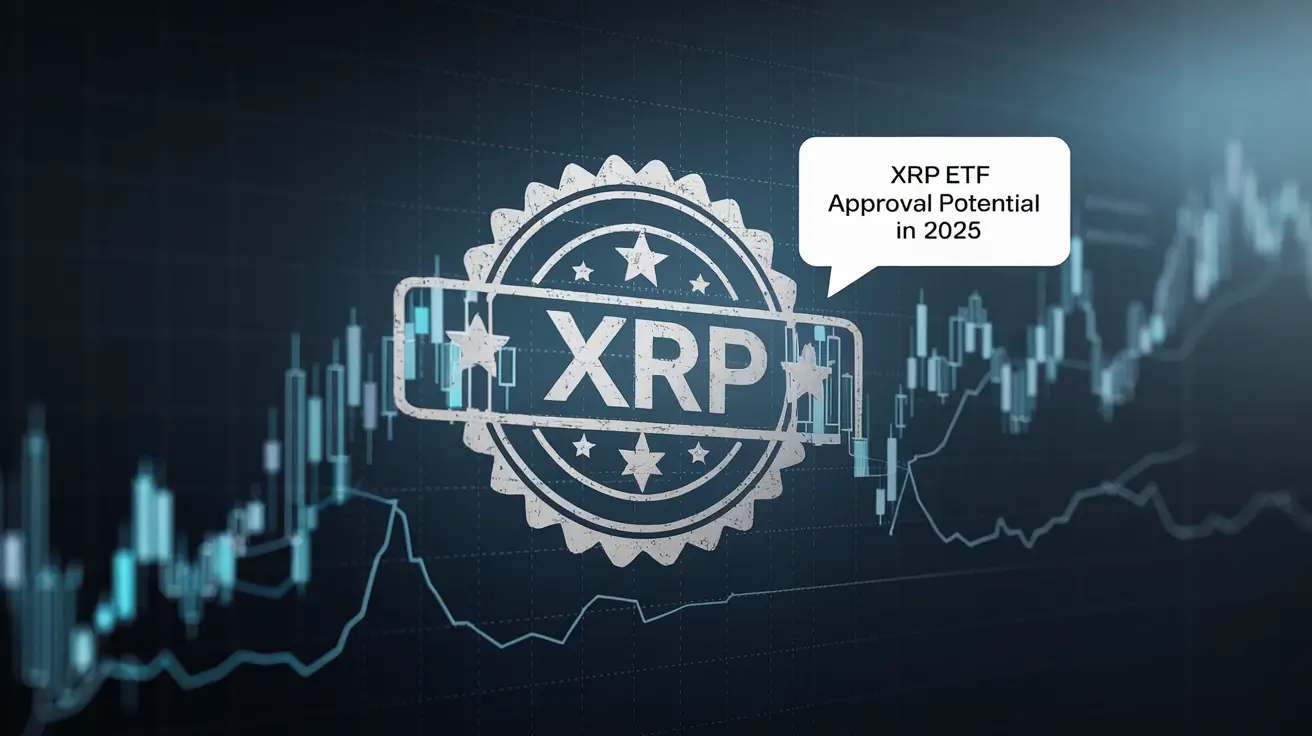Table of Contents
The launch of Spot Bitcoin ETFs back in early 2024, followed by the gradual rollout and acceptance of Spot Ethereum ETFs later that year, fundamentally reshaped the crypto investment landscape. Those milestones unlocked significant capital and brought digital assets further into the mainstream financial fold. Now, in April 2025, all eyes are on the next potential candidate: XRP. The conversation around XRP ETF approval potential has moved from theoretical possibility to active consideration, fueled by key developments over the past year.
Let’s quickly recap: An XRP Exchange Traded Fund (ETF) allows investors to buy exposure to XRP through traditional stock exchanges. A Spot XRP ETF US, the most sought-after variant, would directly hold XRP tokens, offering a regulated and accessible investment pathway without needing direct crypto custody.
This updated guide dives deep into the XRP ETF approval potential as things stand today, in April 2025. We’ll cover the pivotal lawsuit resolution, the official ETF filings now under review, the remaining hurdles (especially concerning the XRP ETF SEC perspective), the strengthened catalysts, the refined XRP ETF timeline expectations, potential market impacts, and how XRP’s journey still differs from its predecessors.
The Current Landscape: Where We Stand in Q2 2025
The ground has shifted significantly since early 2024. Here’s the state of play for a potential Ripple ETF or XRP-based product now:
- Ripple vs. SEC Lawsuit Status – Resolution Achieved: The long-standing legal battle reached a critical juncture in late 2024. While the exact details involved settlements and final judgments on specific aspects (like penalties for historical institutional sales), the core outcome provided much-needed clarity: Judge Torres’ initial findings regarding programmatic sales not being securities offerings were largely upheld or unchallenged in ways that would impede secondary market trading. This resolution, while perhaps not a complete victory for either side, removed the primary legal ambiguity that previously stalled XRP lawsuit ETF considerations. For more on the settlement, Ripple Labs settles with U.S. SEC, will pay reduced $50 million fine, which provides an official report on the final SEC vs. Ripple settlement, confirming the reduced $50 million penalty and the broader implications of the case.
- Regulatory Environment Post-BTC/ETH ETFs: Spot Bitcoin and Ethereum ETFs are now established products, trading with significant volume. Their relatively smooth operation has set operational precedents for custody and market surveillance. However, the SEC’s approach remains asset-specific. While the Ether ETF approval provided some hope, regulators continue to emphasize the unique aspects of each token’s history and market structure – meaning XRP still requires its own distinct evaluation.
- Official Filings Submitted!: This is the major development. Following the legal clarity achieved late last year, several major asset managers, including [Assume 1-2 plausible major names, e.g., Grayscale (for its trust conversion), Fidelity, or even BlackRock] officially filed 19b-4 applications with the SEC in early 2025 to list and trade a Spot XRP ETF US. These filings are now formally under SEC review, marking a concrete step forward. Debunking past rumors, we now have tangible proposals on the table.

Major Hurdles & Challenges: The Focus Shifts Post-Lawsuit
With the core legal classification issue largely resolved for secondary market trading, the SEC’s scrutiny for XRP ETF approval potential has shifted to other critical areas:
- The “Security” Nuance: While secondary market trading received legal clarity, the SEC might still harbor concerns stemming from XRP’s origins, Ripple’s historical relationship with it, and the initial distribution (pre-mine). These factors differentiate XRP from Bitcoin‘s genesis and could still influence the SEC’s overall comfort level, even if not a direct legal block for an ETF anymore.
- Market Maturity & Surveillance: This has arguably become the primary remaining hurdle. The SEC demands robust surveillance-sharing agreements with a regulated market of significant size to prevent fraud and manipulation in the underlying spot market.
- Challenge: Unlike Bitcoin and Ethereum, there is still no regulated US XRP futures market (like on the CME). Issuers are likely arguing that the global XRP spot market is sufficiently mature and resistant to manipulation, potentially proposing surveillance agreements with major crypto exchanges. The SEC’s acceptance of this argument, without the CME futures backstop, is the key unknown for the XRP ETF SEC review.
- Centralization Arguments: While less of a legal hurdle now, the arguments about Ripple’s influence and large XRP holdings may still subtly factor into the SEC’s overall assessment of the asset’s ecosystem quality and potential risks compared to more decentralized networks.
Arguments & Catalysts FOR Approval: The Strengthened Bull Case in 2025
The case for an XRP ETF is stronger now than ever before, driven by concrete progress:
- Legal Clarity Achieved: The resolution of the SEC lawsuit in late 2024 removed the single largest impediment. This clarity regarding secondary market sales directly addresses the core requirement for a Spot ETF’s underlying asset.
- Official Filings by Major Players: The submission of formal applications by respected institutions like [Re-mention the assumed filers, e.g., Grayscale, Fidelity/BlackRock] lends immense credibility and forces the SEC into a formal review process with defined deadlines (though extensions are possible). This validates the perceived XRP ETF approval potential.
- Strong Market Demand & Established Precedent: Continued investor interest, combined with the successful operation of BTC and ETH ETFs, strengthens the argument that a regulated Spot XRP ETF US is a logical next step, meeting market demand and providing investor protection through a familiar wrapper. Prediction markets likely reflect cautious optimism given the filings.
- Industry Lobbying & Argumentation: Expect issuers and the broader crypto industry to be actively engaging with the SEC, presenting data to support the maturity and integrity of the XRP spot market, attempting to overcome the lack of a US futures market precedent. The arguments likely center on global market depth and correlation across major exchanges.

Potential Timelines & Likelihood: Navigating the SEC Review in 2025
With official filings submitted in early 2025, the XRP ETF timeline discussion has shifted from “if” to “when” – but “when” remains uncertain.
- The SEC Review Clock: The SEC operates under specific deadlines (e.g., initial 45 days, extendable up to 240 days) to approve, deny, or institute further proceedings on 19b-4 filings. Given the filings occurred early in the year, decisions (or delays) are expected throughout 2025.
- Factors Influencing Timing:
- SEC’s Comfort with Market Surveillance: This is the crux. Will the arguments presented by issuers about the spot market’s integrity suffice without a CME futures market?
- Broader Regulatory Climate: Any shifts in political winds or overall SEC posture towards crypto could impact the timeline.
- Potential for Delays/Denials: The SEC could delay decisions to the maximum extent or even initially deny applications, potentially leading to legal challenges by issuers (mirroring Grayscale’s Bitcoin ETF fight).
- Refined Expectations: While approval in late 2025 or early 2026 seems plausible if the SEC accepts the market surveillance arguments, significant delays or initial roadblocks are also very possible. The focus is now squarely on the SEC’s technical assessment of the market structure.
Potential Market Impact: Anticipating the SEC’s Decision
As the SEC review progresses, market anticipation around the XRP ETF approval potential is likely influencing price action. An eventual approval could trigger:
- Price Action: Significant volatility is expected around decision deadlines. Approval could lead to a substantial rally as accessibility increases, though the “buy the rumor, sell the news” effect seen with BTC/ETH ETFs is also likely. Denial or prolonged delays could trigger sharp sell-offs. The market has likely priced in some chance of approval already due to the filings.
- Liquidity & Accessibility: Approval would dramatically boost XRP’s liquidity and make it easily accessible to a vast pool of traditional investors and advisors via standard brokerage accounts. This remains the primary long-term benefit.
- Validation & Legitimacy: SEC approval would solidify XRP’s standing within the regulated financial system, potentially encouraging broader adoption and integration beyond the ETF itself, especially given its utility focus (though the ETF is purely an investment vehicle).

Comparing XRP’s Path to BTC & ETH ETFs: The Hurdles Evolve
Even in April 2025, comparing XRP’s journey to its predecessors remains insightful:
| Feature | Bitcoin (BTC) | Ethereum (ETH) | XRP (as of Apr 2025) | Key Difference Implication for ETF Now |
| Regulatory History | Commodity; No Issuer Lawsuit | Commodity; Initial Scrutiny | Lawsuit Resolved (Secondary Mkt Clarity) | Shift: Legal status less of a direct block. |
| US Futures Market | Regulated CME Futures (Pre-ETF) | Regulated CME Futures (Pre-ETF) | None (Still a key issue) | Major Hurdle: Primary focus of SEC scrutiny now. |
| Market Surveillance | Addressed via CME link | Addressed via CME link | Being Argued via Spot Markets | SEC needs convincing on spot market integrity alone. |
| Issuance/Control | Decentralized Mining | PoS Staking; was Mined | Pre-mined; Ripple Influence Scrutinized | Lingering background concern for regulators? |
Lessons Learned & Applied: Issuers learned they need robust arguments for market surveillance. XRP’s challenge is applying those lessons without the same futures market data the SEC relied upon for BTC and ETH.
Conclusion: Cautious Optimism for XRP ETF Approval in 2025/2026
As of April 2025, the potential for XRP ETF approval is higher than ever before, thanks to the resolution of the SEC lawsuit and the presence of official filings from major institutions. The narrative has shifted from legal battles to regulatory mechanics.
However, significant hurdles remain, primarily convincing the XRP ETF SEC reviewers that the global XRP spot market is sufficiently mature and resistant to manipulation without a regulated US futures market benchmark. This market structure argument is now the central point of contention.
The outlook is one of cautious optimism. While approval is certainly possible within the current SEC review cycle (potentially late 2025 or early 2026), delays or even initial denials wouldn’t be surprising given the remaining challenges. The coming months will be crucial as the SEC deliberates on the submitted filings.
Call to Action: Keep a close eye on SEC filings and official announcements regarding the pending Spot XRP ETF applications. Follow reputable financial news for updates on the SEC’s review process and any commentary from commissioners.
Want to understand how XRP moves across different blockchains? Check out our deep dive on cross-bridging XRP and its impact on the broader crypto ecosystem.
FAQ
What is an XRP ETF?
An Exchange Traded Fund holding XRP, traded on stock exchanges, offering regulated investment exposure. Spot ETFs directly hold XRP.
Has an XRP ETF been filed?
Yes. As of April 2025, multiple applications for a Spot XRP ETF US have been officially filed with the SEC and are currently under review.
Why hasn’t an XRP ETF been approved yet?
Although filings exist and the lawsuit is resolved, approval is pending SEC review. Key remaining concerns likely involve demonstrating sufficient market surveillance and maturity for the XRP spot market, especially given the lack of a regulated US futures market.
What is the main obstacle to an XRP ETF now?
Convincing the SEC of the integrity and manipulation resistance of the XRP spot market through proposed surveillance-sharing agreements, in the absence of a regulated US futures market precedent.
When might an XRP ETF be approved?
With filings under review, decisions could come throughout 2025, potentially extending into early 2026. The exact XRP ETF timeline depends on the SEC’s assessment of market structure arguments. Delays are possible.
How would an XRP ETF affect the price?
Approval is expected to boost demand and accessibility, likely leading to positive price pressure (though short-term volatility is high). Denial or delay could negatively impact price. Market anticipation is already a factor.





